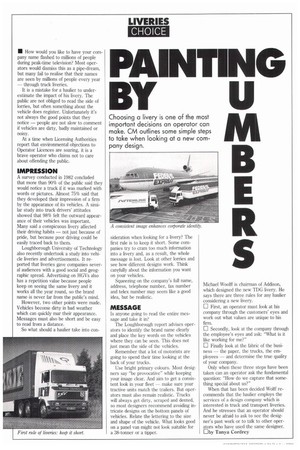MESSAGE
Page 30

If you've noticed an error in this article please click here to report it so we can fix it.
Is anyone going to read the entire message and take it in?
The Loughborough report advises operators to identify the brand name clearly and place the key words on the vehicles where they can be seen. This does not just mean the side of the vehicles.
Remember that a lot of motorists are going to spend their time looking at the back of your trucks.
Use bright primary colours. Most designers say "be provocative" while keeping your image clear. And aim to get a consistent look in your fleet — make sure your tractive units match the trailers. But operators must also remain realistic. Trucks will always get dirty, scraped and dented, so most designers recommend avoiding intricate designs on the bottom panels of vehicles. Relate the lettering to the size and shape of the vehicle. What looks good on a panel van might not look suitable for a 38-tonner or a tipper. Michael Woolf is chairman of Addison, which designed the new TDG livery. He says there are three rules for any haulier considering a new livery.
O First, an operator must look at his company through the customers' eyes and work out what values are unique to his firm.
O Secondly, look at the company through the employee's eyes and ask: "What is it like working for me?"
Finally look at the fabric of the busi
ness the paper, the trucks, the employees — and determine the true quality of your company.
Only when these three steps have been taken can an operator ask the fundamental question: "How do we capture that something special about us?"
When that has been decided Wolff recommends that the haulier employs the services of a design company which is interested in truck and transport liveries. And he stresses that an operator should never be afraid to ask to see the designer's past work or to talk to other operators who have used the same designer.
O by Tanya Corilrey




























































































































